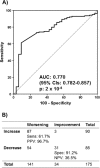Increase of circulating endocan over sepsis follow-up is associated with progression into organ dysfunction
- PMID: 28455780
- PMCID: PMC7101577
- DOI: 10.1007/s10096-017-2988-6
Increase of circulating endocan over sepsis follow-up is associated with progression into organ dysfunction
Abstract
How circulating inflammatory mediators change upon sepsis progression has not been studied. We studied the follow-up changes of circulating vasoactive peptides and cytokines until the improvement or the worsening of a patient and progression into specific organ dysfunctions. In a prospective study, concentrations of tumor necrosis factor-alpha (TNFα), interleukin (IL)-6, IL-8, IL-10, interferon-gamma (IFNγ), endocan and angiopoietin-2 (Ang-2) were measured in serum by an enzyme immunoassay in 175 patients at baseline; this was repeated within 24 h upon progression into new organ dysfunction (n = 141) or improvement (n = 34). Endocan and Ang-2 were the only parameters that were significantly increased among patients who worsened. Any increase of endocan was associated with worsening with odds ratio 16.65 (p < 0.0001). This increase was independently associated with progression into acute respiratory distress syndrome (ARDS) as shown after logistic regression analysis (odds ratio 2.91, p: 0.002). Changes of circulating cytokines do not mediate worsening of the critically ill patients. Instead endocan and Ang2 are increased and this may be interpreted as a key-playing role in the pathogenesis of ARDS and septic shock. Any increase of endocan is a surrogate of worsening of the clinical course.
Keywords: Acute Kidney Injury; Acute Lung Injury; Organ Dysfunction; Septic Shock; Systemic Inflammatory Response Syndrome.
Conflict of interest statement
None of the authors has any conflict of interest related to this submission.
Figures




References
-
- Singer M, Deutschman CS, Seymour CW, Shankar-Hari M, Annane D, Bauer M, Bellomo R, Bernard GR, Chiche JD, Coopersmith CM, Hotchkiss RS, Levy MM, Marshall JC, Martin GS, Opal SM, Rubenfeld GD, van der Poll T, Vincent JL, Angus DC. The third international consensus definitions for sepsis and septic shock (sepsis-3) JAMA. 2016;315:801–810. doi: 10.1001/jama.2016.0287. - DOI - PMC - PubMed
-
- Bechard D, Gentina T, Delehedde M, Scherpereel A, Lyon M, Aumercier M, Vazeux R, Richet C, Degand P, Jude B, Janin A, Fernig DG, Tonnel AB, Lassalle P. Endocan is a novel chondroitin sulfate/dermatan sulfate proteoglycan that promotes hepatocyte growth factor/scatter factor mitogenic activity. J Biol Chem. 2001;276:48341–48349. doi: 10.1074/jbc.M108395200. - DOI - PubMed
MeSH terms
Substances
LinkOut - more resources
Full Text Sources
Other Literature Sources
Medical
Miscellaneous

